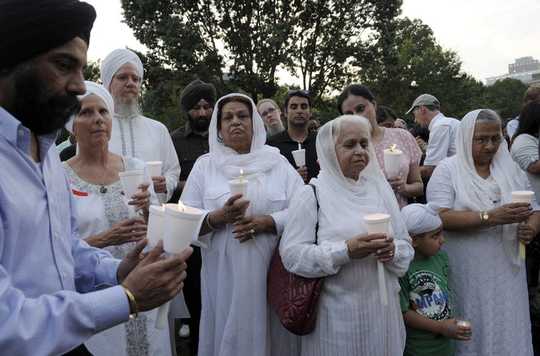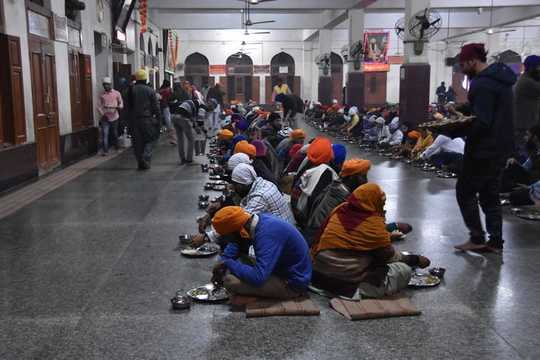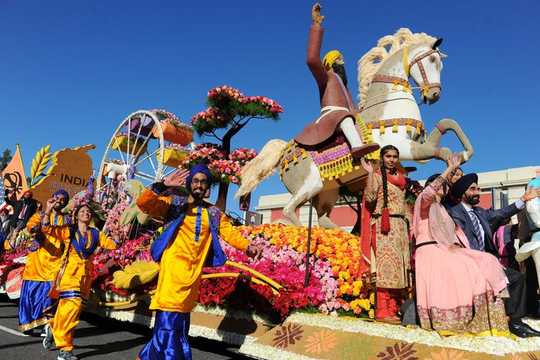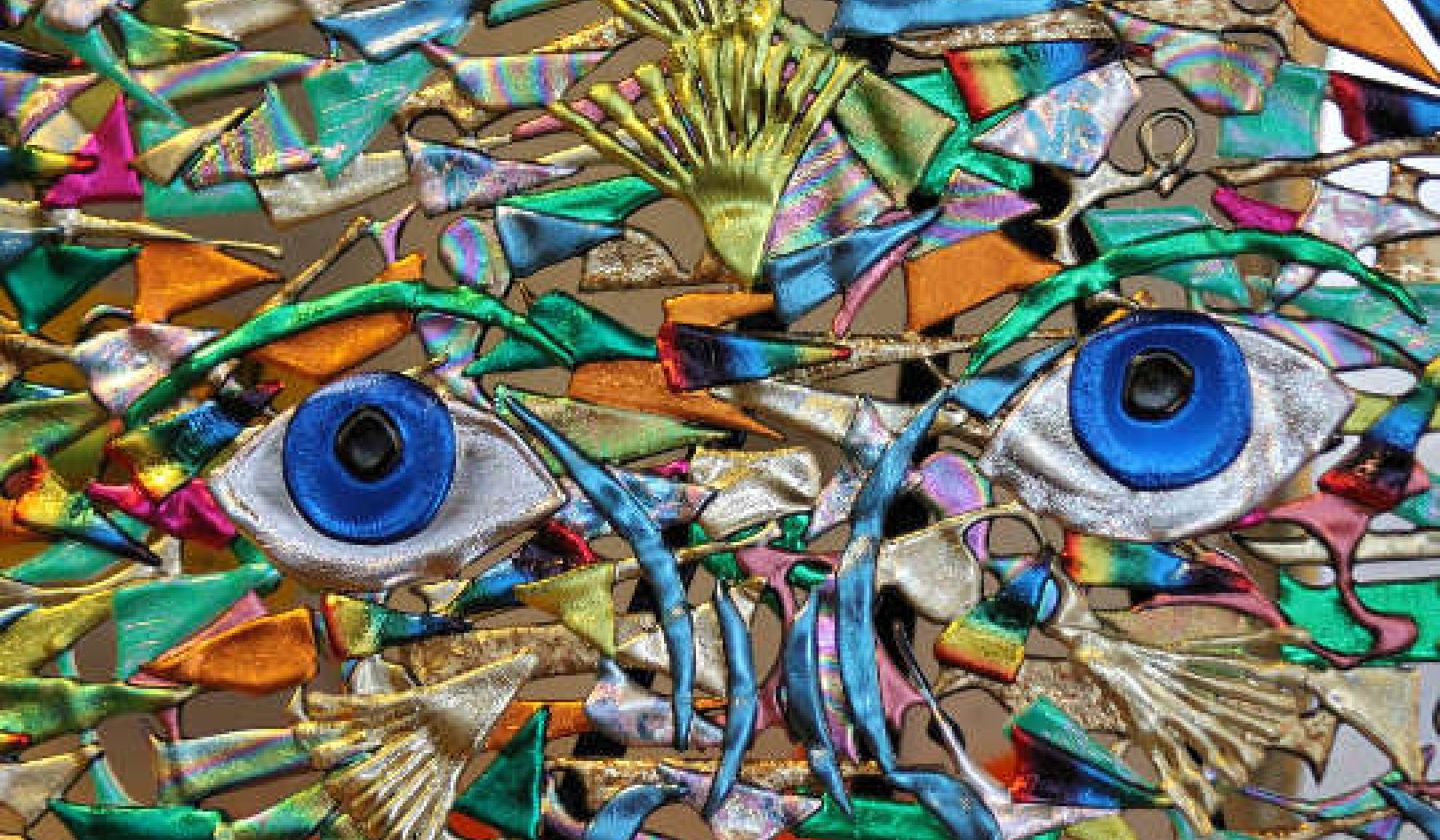
People participate in a candlelight vigil near the White House to protest violence against Sikhs in 2012. AP Photo/Susan Walsh
An elderly Sikh gentleman in Northern California, 64-year-old Parmjit Singh, was recently stabbed to death while taking a walk in the evening. Authorities are still investigating the killer’s motive, but community members have asked the FBI to investigate the killing.
For many among the estimated 500,000 Sikhs in the U.S., it wouldn’t be the first time. According to the Sikh Coalition, the largest Sikh civil rights organization in North America, this is the seventh such attack on an elderly Sikh with a turban in the past eight years.
As a scholar of the tradition and a practicing Sikh myself, I have studied the harsh realities of what it means to be a Sikh in America today. I have also experienced racial slurs from a young age.
I have found there is little understanding of who exactly the Sikhs are and what they believe. So here’s a primer.
Founder of Sikhism
The founder of the Sikh tradition, Guru Nanak, was born in 1469 in the Punjab region of South Asia, which is currently split between Pakistan and the northwestern area of India. A majority of the global Sikh population still resides in Punjab on the Indian side of the border.
From a young age, Guru Nanak was disillusioned by the social inequities and religious hypocrisies he observed around him. He believed that a single divine force created the entire world and resided within it. In his belief, God was not separate from the world and watching from a distance, but fully present in every aspect of creation.
He therefore asserted that all people are equally divine and deserve to be treated as such.
To promote this vision of divine oneness and social equality, Guru Nanak created institutions and religious practices. He established community centers and places of worship, wrote his own scriptural compositions and institutionalized a system of leadership (gurus) that would carry forward his vision.
The Sikh view thus rejects all social distinctions that produce inequities, including gender, race, religion and caste, the predominant structure for social hierarchy in South Asia.

A community kitchen run by the Sikhs to provide free meals irrespective of caste, faith or religion, in the Golden Temple, in Punjab, India. shankar s., CC BY
Serving the world is a natural expression of the Sikh prayer and worship. Sikhs call this prayerful service “seva,” and it is a core part of their practice.
The Sikh identity
In the Sikh tradition, a truly religious person is one who cultivates the spiritual self while also serving the communities around them – or a saint-soldier. The saint-soldier ideal applies to women and men alike.
In this spirit, Sikh women and men maintain five articles of faith, popularly known as the five Ks. These are: kes (long, uncut hair), kara (steel bracelet), kanga (wooden comb), kirpan (small sword) and kachera (soldier-shorts).
Although little historical evidence exists to explain why these particular articles were chosen, the five Ks continue provide the community with a collective identity, binding together individuals on the basis of a shared belief and practice. As I understand, Sikhs cherish these articles of faith as gifts from their gurus.
Turbans are an important part of the Sikh identity. Both women and men may wear turbans. Like the articles of faith, Sikhs regard their turbans as gifts given by their beloved gurus, and their meaning is deeply personal. In South Asian culture, wearing a turban typically indicated one’s social status – kings and rulers once wore turbans. The Sikh gurus adopted the turban, in part, to remind Sikhs that all humans are sovereign, royal and ultimately equal.
Sikhs in America
Today, there are approximately 30 million Sikhs worldwide, making Sikhism the world’s fifth-largest major religion.

‘A Sikh-American Journey’ parade in Pasadena, Calif. AP Photo/Michael Owen Baker
After British colonizers in India seized power of Punjab in 1849, where a majority of the Sikh community was based, Sikhs began migrating to various regions controlled by the British Empire, including Southeast Asia, East Africa and the United Kingdom itself. Based on what was available to them, Sikhs played various roles in these communities, including military service, agricultural work and railway construction.
The first Sikh community entered the United States via the West Coast during the 1890s. They began experiencing discrimination immediately upon their arrival. For instance, the first race riot targeting Sikhs took place in Bellingham, Washington, in 1907. Angry mobs of white men rounded up Sikh laborers, beat them up and forced them to leave town.
The discrimination continued over the years. For instance, when my father moved from Punjab to the United States in the 1970s, racial slurs like “Ayatollah” and “raghead” were hurled at him. It was a time when 52 American diplomats and citizens were taken captive in Iran and tension between the two countries was high. These slurs reflected the racist backlash against those who fitted the stereotypes of Iranians. Our family faced a similar racist backlash when the U.S. engaged in the Gulf War during the early 1990s.
Increase in hate crimes
The racist attacks spiked again after 9/11, particularly because many Americans did not know about the Sikh religion and may have conflated the unique Sikh appearance with popular stereotypes of what terrorists look like. News reports show that in comparison to the past decade, the rates of violence against Sikhs have surged.
Elsewhere too, Sikhs have been victims of hate crimes. An Ontario member of Parliament, Gurrattan Singh, was recently heckled with Islamophobic comments by a man who perceived Singh as a Muslim.
As a practicing Sikh, I can affirm that the Sikh commitment to the tenets of their faith, including love, service and justice, keeps them resilient in the face of hate. For these reason, for many Sikh Americans, like myself it is rewarding to maintain the unique Sikh identity.
About The Author
Simran Jeet Singh, Henry R. Luce Post-Doctoral Fellow in Religion in International Affairs Post-Doctoral Fellow, New York University
This article is republished from The Conversation under a Creative Commons license. Read the original article.

Related Books:
Prayer Journal for Women: 52 Week Scripture, Devotional & Guided Prayer Journal
by Shannon Roberts and Paige Tate & Co.
This book offers a guided prayer journal for women, with weekly scripture readings, devotional prompts, and prayer prompts.
Click for more info or to order
Get Out of Your Head: Stopping the Spiral of Toxic Thoughts
by Jennie Allen
This book offers insights and strategies for overcoming negative and toxic thoughts, drawing on biblical principles and personal experiences.
Click for more info or to order
The Bible in 52 Weeks: A Yearlong Bible Study for Women
by Dr. Kimberly D. Moore
This book offers a yearlong Bible study program for women, with weekly readings and reflections, study questions, and prayer prompts.
Click for more info or to order
The Ruthless Elimination of Hurry: How to Stay Emotionally Healthy and Spiritually Alive in the Chaos of the Modern World
by John Mark Comer
This book offers insights and strategies for finding peace and purpose in a busy and chaotic world, drawing on Christian principles and practices.
Click for more info or to order
The Book of Enoch
translated by R.H. Charles
This book offers a new translation of an ancient religious text that was excluded from the Bible, offering insights into the beliefs and practices of early Jewish and Christian communities.
Click for more info or to order

























